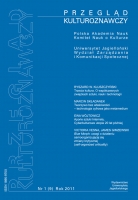Aporie sztuki Internetu. Cyberkulturowe utopie 20 lat później
APORIAS OF THE INTERNET ART. CYBERCULTURAL UTOPIAS TWENTY YEARS LATER
Author(s): Ewa WójtowiczSubject(s): Cultural Essay, Political Essay, Societal Essay
Published by: Wydawnictwo Uniwersytetu Jagiellońskiego
Keywords: INTERNET ART; CYBERCULTURE; DEHUMANIZATION
Summary/Abstract: During the last two decades almost all the utopias of freedom, communication, access and cultural diversity have faced, respectively, problems of cenzorship, e-invigilation, exclusion and aesthetic homogenization. The reflection on cyberculture in its first years was characterized by the development of methodology, fascination with the unknown, the lack of technical knowledge, access difficulties and a great enthusiasm. Therefore we can distinguish some common attitudes, like the fear of dehumanization and losing real contacts for the sake of virtual ones. Also, in the 90s were the decade of great interest in telepresence and cyborg-like body prosthetics. One of the key features is adding the prefix „cyber-” to many words and relating to fiction (mostly literature and cinema). Artistic activity may be traced halfway between fiction and science-based technology. As network-based decentralization has played a positive role, it also has a double meaning. There is no responsibility and no direct enemy that may be criticised. This problem may be considered as a central aporia of the digital avantgarde, to use the term coined by Hans Magnus Enzensberger. Since networks are no longer metaphors, as Eugene Thacker notices, they become real, but still unstable. Artists using networks are involved in many contexts, sometimes disappointed with utopias of freedom and visions of endless space. All this creates a complex picture of art within cyberculture twenty years after its emergence.
Journal: Przegląd Kulturoznawczy
- Issue Year: 9/2011
- Issue No: 1
- Page Range: 46-54
- Page Count: 9
- Language: Polish

